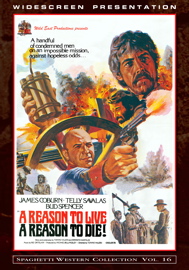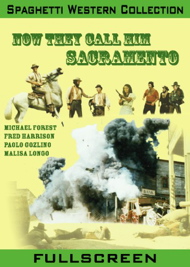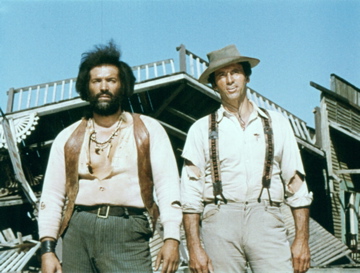| Release List | Reviews | Price Search | Shop | Newsletter | Forum | DVD Giveaways | Blu-Ray/ HD DVD | Advertise |
| Reviews & Columns |
|
Reviews DVD TV on DVD Blu-ray International DVDs Theatrical Reviews by Studio Video Games Features Collector Series DVDs Easter Egg Database Interviews DVD Talk TV DVD Talk Radio Feature Articles Columns Anime Talk DVD Savant HD Talk Horror DVDs Silent DVD
|
DVD Talk Forum |
|
|
| Resources |
|
DVD Price Search Customer Service #'s RCE Info Links |
|
Columns
|
 |
Savant Guest Reviews:
A Reason to Live, A Reason to Die |

|
A Reason to Live, A Reason to Die Wild East 1972 / Colour / 2.35:1 anamorphic 16:9 / 114 m. / Una Ragione per Vivere e una per Morire, Massacre at Fort Holman Starring James Coburn, Telly Savalas, Bud Spencer, Benito Stefanelli, Georges Geret, Ugo Fangareggi, Reinhard Kolldehoff, Guy Mairesse, Adolfo Lastretti, Fabrizio Moresco, Cinematography Alejandro Ulloa Production Designer Benjamin Jacobson Film Editors Franco Fraticelli and Franklin Brill Original Music Riz Ortolani Written by Rafael Azcona, Ernesto Gastaldi, Jay Lynn, Howard Sandford and Tonino Valerii Produced by Michael Billingsley, Tullio Odevaine, Alfonso Sansone and Arthur Steloff Directed by Tonino Valerii |
After filming A Fistful of Dynamite/Duck You Sucker with Sergio Leone in 1971, James Coburn returned to Almeria in 1972 to shoot A Reason to Live, A Reason to Die with Leone's former assistant director, Tonino Valerii (Day of Anger, My Name is Nobody). Valerii and his team had their fingers firmly on the pulse of 1970s action cinema trends and A Reason to Live, A Reason to Die represents a near perfect example of the kind of big-budgeted action extravaganzas that flourished during that decade.
Coburn's Colonel Pembroke has a tough time keeping his criminal charges in line initially and there are times when it looks like he might not live long enough to make it to Fort Holman. Then again, the whole squad receives a rude awakening when a stop-off at an innocuous looking homestead throws up some nasty surprises. This section of the film plays like it might have influenced a vaguely similar scenario that crops up in Sam Peckinpah's Coburn vehicle, Cross of Iron. But it's when they arrive at Fort Holman that the squad's troubles really begin. The fort is protected by a highly sophisticated alarm system and access to its inner courtyard is made extremely difficult by a number of novel security measures. The only chance of success that the squad has involves negotiating a dangerous cliff face that leads to a plateau that is linked to the fort by a precarious suspension bridge. The squad's attempts to take out the alarm system and gain some kind of access to the fort's inner areas prompt some really tense and suspense-laden set pieces that are superbly executed. The fact that the fort is home to hundreds of Confederate troops means that an explosive 'few against many', The Wild Bunch-like final confrontation is inevitable.
Valerii helmed five Italian Westerns and all five are quite different in their content and approach. The Price of Power, a stylish and political film that allegorically relocated the Kennedy assassination to the Spaghetti West of 1890, is perhaps his most striking and original Western. But, in terms of production values, plotting and pacing, A Reason to Live, A Reason to Die just might be his best shot at a big budget crowd-pleaser. The film does feature the odd incidental political observation though. One potential recruit who turns down the chance to join Pembroke is a religious man who was arrested and condemned for mounting a protest against the war. Valerii's work usually shows the influence of Leone in terms of thoughtful blocking and composition, good coverage of scenes from a number of angles, impressive art direction and neat camera moves but he never gives the impression that he's trying to consciously mimic Leone: we're simply left with the impression that Valerii knows how to put a good looking film together and A Reason to Live, A Reason to Die is another feather in his cap in this regard: there's some really outstanding cinematography on display here. Genre stalwart Riz Ortolani provides a beautiful but melancholic soundtrack score that sounds as if it might have influenced Ennio Morricone's music for Once Upon a Time in America.
A Reason to Live, A Reason to Die has previously existed in two distinct forms: American/British edits that invariably ran anywhere between 79 and 91 minutes and a much longer European edit. The American/British edits often featured a prologue that was missing from the longer European version. Here Wild East present the longest possible version of the film: by adding the US/UK prologue to the longer European edit of the film, the company have put together a definitive version that runs to 114 minutes. James Coburn fans should note that the actor didn't dub himself in the longer version of the film and the services of a dubbing actor were employed instead. Some of those who were previously familiar with the shorter US/UK versions of the film, which Coburn did dub, report that they find the presence of the 'new' voice a little distracting. I have to say that I found the dubbing actor's voice to be a pretty good match and soon forgot that it wasn't actually Coburn on the soundtrack. The dubbing certainly didn't stop me from enjoying the actor's assured and convincing performance here.
The show's other actors acquit themselves well too for the most part. Bud Spencer (Ace High) gets a lot of screen time as the vagabond Eli Sampson and there are some interesting early scenes that set up his relationship with Pembroke. The pair first meet in a shattered New Mexico town where martial law is in force to deter desperate and starving Civil War refugees from looting for provisions. Sergio Leone regular Benito Stefanelli puts in a good showing as another member of Pembroke's squad. The squad also features Guy Mairesse, Ugo Fangareggi, Adolfo Lastretti, Reinhard Kolldehoff and Giuseppe Pollini, who are all given unfamiliar pseudonyms in the film's credits. Telly Savalas was responsible for some superb genre performances as a Mexican bandit (Pancho Villa, A Town Called Hell) but he looks a little stiff and uncomfortable in his role as a Southern Major here and he turns in a fairly subdued performance. The show's production values are very high and the Fort Holman set is really quite impressive. The same fort set appeared in a number of other Euro Westerns but Valerii and cinematographer Alejandro Ulloa (Companeros, The Diabolical Doctor Z) capture the fort's interior from some great angles that serve to make it look both really huge and unfamiliar.
The picture quality of the main body of the film presented here is excellent. The colours are strong and the image is sharp. Note that the prologue, the front titles and the end titles used here were taken from a source that was in somewhat poorer condition than the near mint source used for the main body of the film. The disc's sound quality remains very good.

|
Now They Call Him Sacramento Dorado Films 1972 / Colour / 1.33:1 flat fullscreen / 88 m. / I Bandoleros della dodicesime ora, Now They Call Him Amen Starring Michael Forest, Fred Harrison, Luigi Bonos, Malisa Longo, Antonio Almoros, Antonio Molino Rojo, Fernando Rubio, Luigi Antonio Guerra, Indio Gonzalez, Juan Torres Cinematography Jaime Deu Casas Production Designer Gisella Longo Film Editor Teresa Alcocer Original Music Willy Breza Written by Alfonso Balcazar and Giovanni Simonelli Produced by Francisco Balcazar Directed by Alfonso Balcazar |
Now They Call Him Sacramento is a film that owes a heavy debt to Terence Hill and Bud Spencer's Trinity series. Hill and Spencer reportedly became rather irked by the rash of look-alike duos that sprung up in the wake of their success as Trinity and Bambino but it seems that the Italian public just couldn't get enough of bickering and brawling tough guy duos during the early 1970s. For a brief rundown on the personality traits of Hill and Spencer's respective characters, check the intro to the review of another Spencer/Hill influenced Spaghetti Western, Ben and Charlie. Those same personality traits are, by and large, written into the characters of Sacramento and Jim here.
Hill and Spencer only did six Spaghetti Westerns as a duo and only three of those were done in full-on, over-the-top Trinity mode. So it's actually quite fun to run into Trinity knock-offs, especially when they're as well observed and executed as Now They Call Him Sacramento is. American actor Michael Forest does a great job as the stand in Terence Hill-type here: his lunky look, goofy grin, athletic disposition and affable demeanour more than stand him in good stead for the part. Furthermore, big Fred Harrison is physically perfect as the stand in Bud Spencer-type and he clearly did his homework with regard to perfecting an impressive take on Spencer's filmic mannerisms. Harrison is actually actor Fernando Bilbao (AKA Fernando Arrien AKA Fred Harris) who played a similarly Spencer-ish role in Antonio Margheriti's madcap but fun martial arts romp, Hercules Against Kung Fu. Bilbao appeared in several Westerns but he's perhaps best known to Euro Horror fans for his role as the Countess's axe man in The Vampires' Night Orgy and his turns as the Frankenstein Monster in the Jess Franco flicks Dracula Prisoner of Frankenstein and The Curse of Frankenstein.

Parts of this show give the impression that Now They Call Him Sacramento was a low-ish budget feature. There's a sequence where a train is meant to stop at two different stations on the same line but the same station is clearly used on both occasions. Other parts of the film give the impression of a much bigger budget: the show's over-the-top but technically impressive finale sees an entire Western town set get demolished by a series of dynamite-induced explosions. But, big budget or low, writer-director Alfonso Balcazar was a seasoned filmmaker who knew how to put a good-looking movie together. The cinematography and other technical aspects of this show hit the required mark throughout. And the kind of budget-induced continuity fluff described above isn't that big a deal when you're busy laughing at the show's genuinely funny comedic content.
The addition of a third character, Jim's father Tequila, for the Trinity-esque duo to bounce off is an interesting move that works well. The double-crossing Tequila is an avaricious, sneaky, foolish and cowardly old Mexican who just can't help getting himself into troublesome situations. But we feel for the old man when he comes across a saloon whose racist owner refuses entry to Mexicans. Actress Malisa Longo plays the feisty beauty Jenny, who is the leader of the colony of disillusioned females. The females make such an impressively determined and pointed strike for independence here that it's tempting to assume that their sub-narrative must be commenting on either the women's liberation movement or some contemporary concern regarding a crisis of masculinity. The bad guys here are largely played for comic effect and they count a pretty well observed Charles Bronson look-alike/act-alike amongst their number. The show's final brawl between our heroes and Cray's bad guys veers perilously close to slapstick overkill but it's brilliantly choreographed. In keeping with many a comedy Spaghetti Western, this show features an ultra-catchy title song that keeps popping up throughout the film. All in all, this is a charming little feature that should appeal to anybody who enjoyed the Trinity films.
Shot and presented fullscreen, Now They Call Him Sacramento plays great when cropped to an approximately correct aspect ratio of 1.77:1 on a widescreen TV. Picture quality here is very good for a flat presentation, remaining reasonably sharp even when zoomed. Taking into account the odd outbreaks of flecks and minor scratches, the odd mild fluctuation in colour quality and a couple of night-time scenes that play on the dark side, this remains a good presentation of a previously hard to come by genre entry. The disc's sound quality is pretty decent too, for the most part. Dorado Films have also granted a DVD release to a rare and thoroughly entertaining pre-A Fistful of Dollars Spaghetti Western, The Last Gun, which stars Cameron Mitchell and Carl Mohner.
On a scale of Excellent, Good, Fair, and Poor,
A Reason to Live, A Reason to Die rates:
Movie: Very Good + / Excellent --
Video: Excellent -
Sound: Very Good
Supplements: three trailers, a TV spot, alternate credits sequence and an image gallery
Now They Call Him Sacramento rates:
Movie: Very Good
Video: Good / Very Good -
Sound: Good / Very Good -
Supplements: photo insert
Packaging: Separate releases in keep cases
Reviewed: March 4, 2007
|
|
| New Review: |
|
|
| Special Offer |
|
| Home | Release List | Coupons | Shop | Reviews | Forum | Video Games | Price Search | Advertise |







